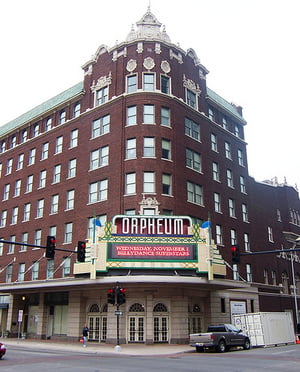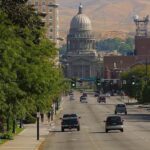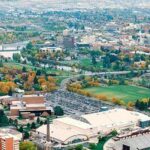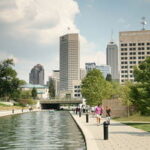This article, the sixteenth in a 50 state series, it lists the largest cities in Kansas by population size and provides demographic details for each city: total population, population by age group, racial composition of the population, land area, and population density.
After reading “Largest Cities in Kansas (2012),” return to this link to read “Best Places to Live in Kansas (2012) .”
Similar articles for the other 49 states can be found at these links: Alabama, Alaska, Arizona, Arkansas, California, Colorado, Connecticut, Delaware, Florida, Georgia, Hawaii, Idaho, Illinois, Indiana, Iowa, Kentucky, Louisiana, Maine, Maryland, Massachusetts, Michigan, Minnesota, Mississippi, Montana, Nebraska, Nevada, New Hampshire, New Jersey, New Mexico, New York, North Carolina, North Dakota, Ohio, Oklahoma, Oregon, Pennsylvania, Rhode Island, South Carolina, South Dakota, Tennessee, Texas, Utah, Vermont, Virginia, Washington, West Virginia, Wisconsin, and Wyoming.
1. Largest Cities in Kansas (2012): Wichita, KS
Located in the central part of southern Kansas, Wichita is the largest city in the state with an estimated population of 372,194.
Grouped by age, 26.8% of the population is under 18, 9.6% is 18 to 24, 27.6% is 25 to 44, 24.3% is 45 to 64, and 11.7% is 65 or older. The median age of the population is 34.5.
The racial composition of the city is 73.5% White, 10.9% Black or African American, 0.7% Native American, 4.5% Asian, 0.1% Pacific Islander, 6.2% from other races, and 4.1% from two or more races. The population is 12.2% Hispanic or Latino of any race.
The land area of the city is 135.8 square miles. The city’s population density is 2,740.75 people per square mile.
2. Largest Cities in Kansas (2012): Overland Park, KS
Situated in northeastern Kansas, Overland Park is the second largest city in the state with an estimated population of 174,928.
Classified by age, 24.3% of the population is under 18, 8.4% is 18 to 24, 28.6% is 25 to 44, 26.5% is 45 to 64, and 12.2% is 65 or older. The median age of the population is 37.8.
The racial complexion of the city is 87.2% White, 3.1% Black or African American, 0.3% Native American, 5.5% Asian, 1.9% from other races, and 1.9% from two or more races. The population is 4.5% Hispanic or Latino of any race.
The land area of the city is 75.2 square miles. The city’s population density is 2,326.17 people per square mile.
3. Largest Cities in Kansas (2012): Kansas City, KS
Located in northeastern Kansas, Kansas City is the third largest city in the state with an estimated population of 142,214.
Categorized by age, 28.8% of the population is under 18, 9.0% is 18 to 24, 27.8% is 25 to 44, 24.1% is 45 to 64, and 10.3% is 65 or older. The median age of the population is 33.3.
The racial profile of the city is 56.8% White, 28.0% Black or African American, 0.8% Native American, 1.9% Asian, 10.3% from other races, and 2.2% from two or more races. The population is 23.8% Hispanic or Latino of any race.
The land area of the city is 124.3 square miles. The city’s population density is 1,144.12 people per square mile.
4. Largest Cities in Kansas (2012): Topeka, KS
Situated in northeastern Kansas, Topeka is the state’s capital and fourth largest city in the state with an estimated population of 124,351.
Sorted by age, 23.7% of the population is under 18, 10.4% is 18 to 24, 27.1% is 25 to 44, 24.5% is 45 to 64, and 14.3% is 65 or older. The median age of the population is 36.1.
The racial makeup of the city is 76.3% White, 11.5% Black or African American, 0.7% Native American, 1.5% Asian, 5.8% from other races, and 4.1% from two or more races. The population is 11.6% Hispanic or Latino of any race.
The land area of the city is 56.0 square miles. The city’s population density is 2,220.55 people per square mile.
5. Largest Cities in Kansas (2012): Olathe, KS
Located in northeastern Kansas, Olathe is the fifth largest city in the state with an estimated population of 121,945.
Arranged by age, 29.9% of the population is under 18, 9.8% is 18 to 24, 32.1% is 25 to 44, 22.4% is 45 to 64, and 5.8% is 65 or older. The median age of the population is 31.7.
The racial mix of the city is 84.9% White, 5.5% Black or African American, 0.6% Native American, 3.7% Asian, 0.1% Pacific Islander, 2.2% from other races, and 3.0% from two or more races. The population is 8.5% Hispanic or Latino of any race.
The land area of the city is 54.2 square miles. The city’s population density is 2,249.91 people per square mile.
Source(s):
“American Community Survey,” U.S. Census Bureau
“American Fact Finder,” U.S. Census Bureau
“Population, Housing Units, Area, and Density: 2000,” U.S. Census Bureau








